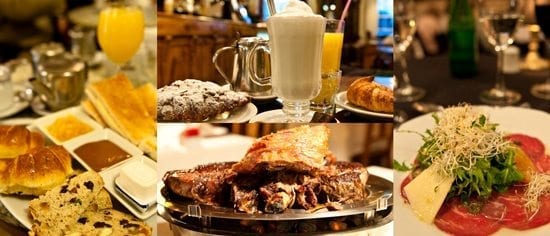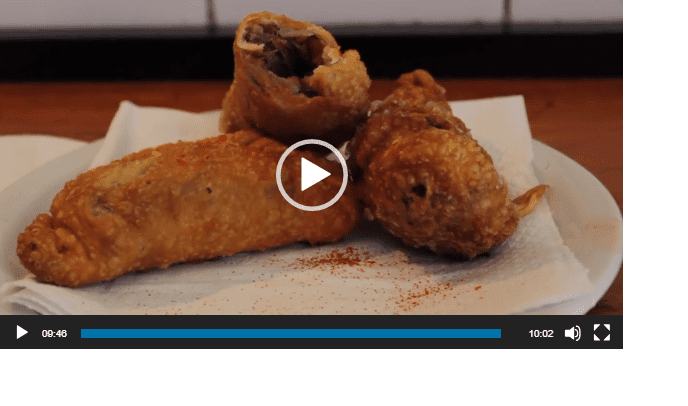Most of the people who came to visit Argentina usually already have a very good idea that locals eat a lot of beef here, and that we eat dinner very late. Once in a while, though, I’d come across some misconceptions from new visitors. For example given Buenos Aires is geographically located right next to the river, one would imagine that we eat a lot of seafood, but that is just the opposite. Fish or any seafood item is rarely consumed, and they are mostly available frozen, not fresh in stores. The one seafood dish that is more commonly embraced is rabas (fried calamari) as an appetizer, and they are served with wedges of lemon only, any kind of dipping sauce is not common.
Another one I’ve come across is that we eat spicy food like the many other Latin cultures, but again it’s quite the opposite. Hot and spicy is not part of the Argentine palate. Generally speaking, they actually don’t like to eat anything spicy. If you want something spicy, you will have to look into international cuisines like Mexican, Peruvian, South Asian, and Indian etc. restaurants in the city.
More often than the occasional misconceptions is the realization of the differences in Argentine food culture. One of the things that foreigners usually notice very early on in their visits is that Argentine don’t eat a lot of vegetables; thus, there’s a very limited variety in salads and vegetable dishes in restaurants. That is a very accurate observation. Vegetables are usually an after thought or just a simple tag-along to the main dish which is probably some kind of meat. For example, it is not uncommon to see ‘tomato’ as an item under the side dishes section in the menu, and it is literally served as just a tomato that has been cut in half. When it comes to salads, they are very simple and basic, no fancy salad dressings, only olive oil and vinegar. The condiments always come separately and you can mix it yourself the way you like it! (P.S. Many Argentines do consider potato, no matter how they are prepared, like papas fritas (french fries) or puré (mashed) as a ‘vegetable’ intake whether or not it’s technically correct.)
Another food item that is very hard to come across is soup and I’m not talking about instant soup mix. In fact, soup has quite a bad reputation culturally. It is, first, not considered to be ‘real food’ and second ‘eating soup’ is often used by parents as punishment for naughty children; definitely not something enjoyable. In a way, it’s like ‘must finish your broccoli’ in the western world. So, in the cold winter or if you come down with a cold, you’ll have to make your own hearty soup if you want one.
 We all know that yerba mate is the national drink of Argentina. It is consumed in a mate cup with a bombilla (metal straw), and ALWAYS with hot water, no matter the weather. Even if it’s at the peak of the summer, bathing in the sun on the beach or in the parks, Argentines still love their yerba mate hot.
We all know that yerba mate is the national drink of Argentina. It is consumed in a mate cup with a bombilla (metal straw), and ALWAYS with hot water, no matter the weather. Even if it’s at the peak of the summer, bathing in the sun on the beach or in the parks, Argentines still love their yerba mate hot.
Also Ready About Yerba Mate 101
Iced tea is a foreign concept and not seen as desirable. Actually, coffee has always been served hot too until Starbucks started popping up everywhere a couple years ago, offering flavored iced coffee and frappuccino. Many local coffee chains then followed suit seeing their popularity grew.
Lastly, everyone is quick to realize that Argentines don’t eat anything salty or eggy for breakfast. Those options won’t be available on the menu in a regular restaurant or cafetería. A typical breakfast consists of sugary facturas (pastries) or toasts with jam/cream/dulce de leche or anything sweet like cookies/cake, plus coffee or tea.
Argentines do love food like eggs and bacon but just not in the morning, which is not the ‘correct time’ (quote from an Argentine friend!) to eat them. You can ask for these food items at a cafetería to see if they could make it for you in the morning, but it’ll definitely be a dead giveaway that you are not from here.
It is always very fascinating to learn about a culture from people’s eating habits. These are just a few curious observations of the Argentine diet, there are many more for you to discover. Whenever you think you are getting some confused looks from locals, you’re probably doing something out of the ordinary without knowing it. Take the chance to ask questions and you’ll be in for an interesting cultural exchange encounter!
We hope you enjoyed our blog! If you are coming to Buenos Aires and would like to Study Spanish you can come visit us at Viamonte 1516, CABA, Argentina







